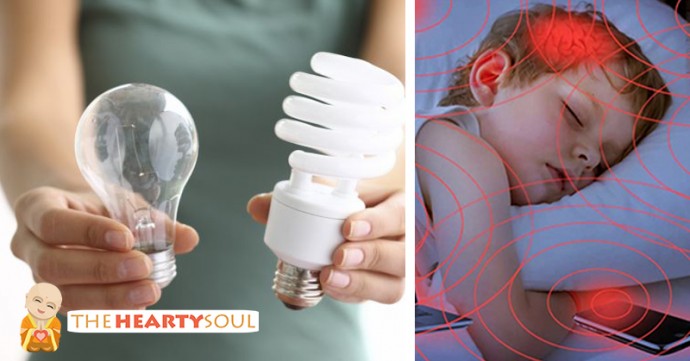
Many of us in the effort to save energy and money, replaced our old standard light bulbs with environmentally-friendly new generation energy saving light bulbs. However, the new generation of energy efficient light bulbs are so toxic that the U.S. Environmental Protection Agency created an emergency protocol you need to follow in the event of a bulb breakage, due to the poison gas that is released. If broken indoors, these light bulbs release 20 times the maximum acceptable mercury concentration into the air, according to a study conducted by researchers from the Fraunhofer Wilhelm Klauditz Institute for German’s Federal Environment Agency.
Energy Efficient Light Bulbs Can Cause:
- Dizziness
- Cluster headaches
- Migraines
- Seizures
- Fatigue
- Inability to concentrate
- Anxiety
Energy Efficient Bulbs Cause Anxiety, Migraines, and Even Cancer. Reasons to Go Back To Incandescent Bulbs
1. Energy saving bulbs contain mercury. Mercury is a potent neurotoxin that is especially dangerous to children and pregnant women. It is especially toxic to the brain, the nervous system, the liver and the kidneys. It can also damage the cardiovascular, immune and reproductive systems. It can lead lead to tremors, anxiety, insomnia, memory loss, headaches, cancer and Alzheimer’s.
2. Energy saving bulbs can cause cancer.
A new study performed by by Peter Braun at Berlin Germany’s Alab Laboratory found these light bulbs contain poisonous carcinogens that could cause cancer:
Phenol, a mildly acidic toxic white crystalline solid, obtained from coal tar and used in chemical manufacture.
Naphthalene, a volatile white crystalline compound, produced by the distillation of coal tar, used in mothballs and as a raw material for chemical manufacture.
Styrene, an unsaturated liquid hydrocarbon, obtained as a petroleum byproduct.
3. Energy saving light bulbs emit a lot of UV rays.
Energy saving lamps emit UV-B and traces of UV-C radiation. It is generally recognized that UV-radiation is harmful for the skin (can lead to skin cancer) and the eyes. The radiation from these bulbs directly attacks the immune system, and furthermore damages the skin tissues enough to prevent the proper formation of vitamin D-3.
So despite the energy and cost savings, these light bulbs pose serious health risks and you may want to change back to regular incandescent bulbs. But be careful while doing so. If one happens to break, the dangers are so severe that the Environmental Protection Agency has laid out a very detailed protocol to deal with the mercury and cancer-causing chemicals, which you can read below:
The Official E.P.A. Broken Bulb Clean-up Procedure
According to the U.S. Environmental Protection Agency, the following emergency procedure should be followed in the event of a bulb breakage, due to the poison gas that is released.
Before Cleanup
- Have people and pets leave the room.
- Air out the room for 5-10 minutes by opening a window or door to the outdoor environment.
- Shut off the central forced air heating/air-conditioning system, if you have one.
Collect materials needed to clean up broken bulb:
- Stiff paper or cardboard
- Sticky tape
- Damp paper towels or disposable wet wipes (for hard surfaces)
- A glass jar with a metal lid or a sealable plastic bag.
During Cleanup
- DO NOT VACUUM. Vacuuming is not recommended unless broken glass remains after all other cleanup steps have been taken. Vacuuming could spread mercury-containing powder or mercury vapor.
- Be thorough in collecting broken glass and visible powder. Scoop up glass fragments and powder using stiff paper or cardboard. Use sticky tape, such as duct tape, to pick up any remaining small glass fragments and powder. Place the used tape in the glass jar or plastic bag. See the detailed cleanup instructions for more information, and for differences in cleaning up hard surfaces versus carpeting or rugs.
- Place cleanup materials in a sealable container.
After Cleanup
- Promptly place all bulb debris and cleanup materials, including vacuum cleaner bags, outdoors in a trash container or protected area until materials can be disposed of. Avoid leaving any bulb fragments or cleanup materials indoors.
- Next, check with your local government about disposal requirements in your area, because some localities require fluorescent bulbs (broken or unbroken) be taken to a local recycling center. If there is no such requirement in your area, you can dispose of the materials with your household trash.
- If practical, continue to air out the room where the bulb was broken and leave the heating/air conditioning system shut off for several hours.
- Please SHARE With Friends !!
Sources:

